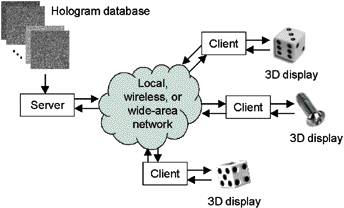| 2004 |

|
YEAR BOOK |
National University of Ireland, Maynooth
|
Internet transmission of digital holograms of
three-dimensional objects
|

Using a standard digital camera and a technique called phase-shift interferometry we can capture 'digital holograms'. These are holograms that can be stored on computer and transmitted over conventional networks. We can also simulate the reconstruction process on a computer. A digital hologram with a million pixels encodes about a million good-quality reconstructions of its 3D scene, all with slightly different perspectives. Packing all of this information into a digital hologram doesn't come cheap; a million pixel digital hologram currently requires 16 million bytes of storage. This makes it impractical for networked applications in its uncompressed form.
Because of their noisy appearance, digital holograms cannot be compressed using lossless compression techniques (gzip, bzip). This, and the fact that each pixel is not a colour but a complex number, means that standard image compression tools (JPEG) cannot be applied successfully either. At NUI Maynooth, we are working to develop the first suite of compression tools for digital holograms. One of our goals is efficient network transmission of digital hologram data. This is particularly challenging because the time required to compress the data must also be taken into account when evaluating the effectiveness of particular compression strategies. A speedup metric is used to combine compression-related transmission gains with the delay caused by the compression process. A special Internet-based networking application (see illustration) is used to empirically verify the benefits compression has on transmission speed.
Applications are a long way off, but they could include 3D television, automated inspection, medical imaging, security, distributed virtual reality, and 3D computer games. This work is in cooperation with Professor Bahram Javidi at University of Connecticut, USA.
Contact: Thomas J. Naughton, Department of Computer Science, NUI Maynooth, Co. Kildare;
E-mail: [email protected] ; Web: www.cs.may.ie/~tnaughton